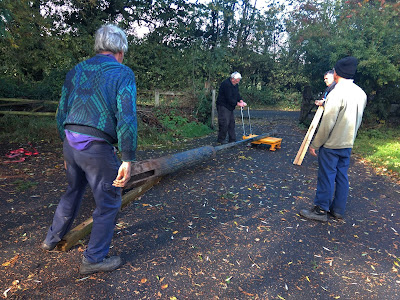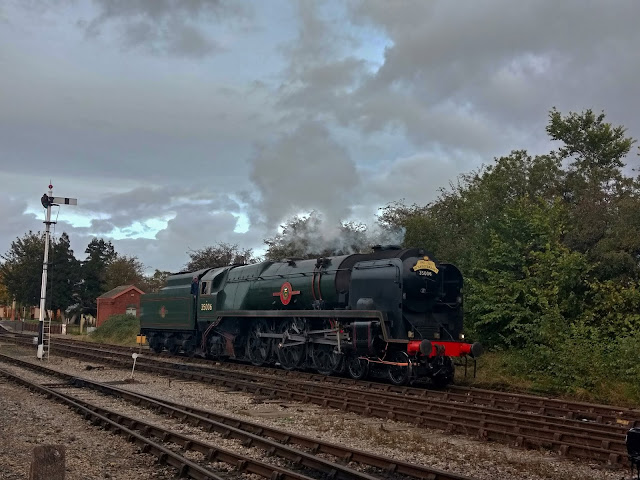Monday at Broadway
Back out of the house after the eye op, so a few careful steps on site, beginning with Broadway. No dust and no hard work allowed though, doctor's orders.
The Malvern side steps were looking quite good. The whole of one side is now equipped with boarding cut to size.
Inside, Neal was fettling short bits of wood to link the upper framing pieces to each other.
In the afternoon Neal had finished fettling the little junction pieces, and had started on the second and last side of the boarding.
On the centre span, John was applying primer to new lengths of boarding, which will be used on the last stretch of the canopy.
Winter may be approaching, but so is the day we will start on the installation!
Tuesday at Broadway
A damp and windy day. It didn't put off our passengers, they were very numerous, although most of them chose one and the same train - the noon departure from Broadway, the only one that permits a round trip from there with steam at this time of year.
But first things first - three coffees, from the cafe, before it gets busy.
It was the DMU, bringing a modest number of passengers, and a similar number was waiting to board.
We watched it depart, then got back to work.
At noon the steamer arrived, this time hauled by our large Pacific, P&O. The platform suddenly became very crowded, and the train looked well filled, which must be good news for the coffers.
It left in a spectacular cloud of steam from the Bulleid, as Neal had a last minute conversation with a member of staff on the train.
Wednesday, on an emergency call out.
What was this then? We received an urgent tip off that a 16ft GWR yard lamp post was available in a garden in Frome. The owner had died, and the house was now for sale. Pick it up quick, or lose it to the new owners, was the message. We had a whip round to cover the cost of purchase, and a member had a friend with lorry.
A week later saw us on the road to Frome.
After a long and dreary journey we found the property in question, down a narrow country lane.
The yard lamp post still had its ladder, and a pair of wide ladder bars. On top was a swan neck lamp fitting.
Neal and John (this was a canopy gang initiative) are already well into digging it out, and luckily there was no concrete underneath.
Here you see Neal removing the ladder, which luckily was not attached in any way. It just lifted off.
The post was painted green, with one coat over another, so one might conclude that it stood in a place that was first GWR, then SR territory?
Nearby are Frome and Westbury.
Without any concrete underneath, we were soon able to shake the post - we 'had it worried'.
We shook it to and fro for quite a while, until the swan neck fitting on top had disengaged itself from the tree that had grown up around it.
Eventually we got this far - about a 45 degree angle. But no more. Normally, when you get this far, you can hang on the top end, and the heavy base hops out of the hole using the edge of the hole as a fulcrum. But this time it would not.
The swan neck light fitting on top was dangling very loosely, so we got a ladder out and managed to pull it off. It appeared to us to be a gas lantern fitting, and there was a long gas pipe up the middle of the pole.
We probably won't need this fitting, so it may be for sale. If you're interested, drop a note to breva2011 (at) hotmail.co.uk.
Neal is a wizzard as far as kit is concerned, so when the bottom refused to budge, he got out a cable with a ratchet, connected the bottom of the post with the trunk of the tree, and applied tension. With the weight of yours truly and John on the top end, it suddenly shot out of the ground, to reveal two timbers underneath, attached with rusty bolts.
Yes, each recovery is different from the last.
With a bit of wire brushing, we were able to reveal the name of the foundry: S.Griffith, Reading.The GWR also had a signal department at Reading.
The owner of the yard lamp post also had some signalling equipment behind his garden shed, quite a bit of it, but piled up in a huge wet, mulchy shambles. It must have lain there for 40 years, we worked out. A short signal post had been there for so long, that a tree had wrapped itself around it in an impenetrable embrace that was so firm, that we had to cut through the hoop at the top, rather that through the wood.
We dragged out all the bits of signal equipment, and put it on the lawn. We even found a Duff jack, a wagon buffer, a 50mph speed restriction sign with arrow (possibly for sale as well).
Then the lorry arrived,with Paul and Terry. We were relieved to hear that the post was planted right next to the drive, but unfortunately reality proved to be slightly different and the lorry with its 18ft bed was unable to pass through the narrow gate. What now? Those yard lamp posts are very heavy, much heavier than platform posts, and twice as long.
Eventually we managed to move it out into the road with a combination of 4 people at one end, and the other on a small trolley that John had brought.
From the roadside the lorry, equipped with a short HIAB, was able to lift it onto the bed.
Immediately after we started his manoeuvre in a small, forgotten country lane, a 14 wheel (!) milk lorry arrived and wanted to get past. Luckily the driver had the patience of a saint, and let us complete the loading of the post.
Two and a half hours later we were all back at Toddington, where we were able to unload the lorry in one go, having stacked everything on a pallet back in Frome. That's thinking ahead.
The goodies were parked outside the steam loco shed. The post was retrieved with the enthusiastic agreement of the steam loco dept, but its future position has still to be communicated to us. It will also need an expensive lamp top, like the other two by the water tower. Funding that could be tricky in these Covid times.
At the end of the day - the evenings are drawing in now - we saw the crew of 35006 park up their stock.
Shortly afterwards they brought P&O back to the coal yard, to coal up for the next occasion. Our passengers had gone home, but those valliant crews were still at work.
Meanwhile, back at home...
... four Usketeers progressed nicely, on a mostly sunny day. Torrential rain first thing and sunshine to end.
 |
| A corner level laid by the door. |
Three mixes were made today, and Julian used up a lot of it to raise the backing up level to the same height as the front, something which had prevented us from laying out any more dressed blocks.
A very enjoyable coffee break was held, using Paul's Vegan (!) mince pies, and John's hot cross buns. It makes your mouth water just writing about them.
 |
| A new quoin on the right, and a new row in front. |
Dave finished the row to the left of the door frame, and then added a complete row to the left and right of the small window fitted a week earlier - see picture above. It's settling in nicely.
 |
| Backing up inside, on the other side of the door. |
Julian backed up several areas including the one above. Rain then stopped play, and lunch was held in the tin shed (our only cover available). Julian kept a safe distance on his own outside, as he was concerned about his wife's recent operation.
That Cheltenham tram survivor
A few more tidbits of information have surfaced about the Cheltenham tram. Three bodies were in fact preserved initially, two of them as roadside shelters (of which one, heavily modified, on Cleeve Hill). However, the roadside shelters were never looked after and slowly decayed until they were after all finally broken up. Only the body of No.21 survived, without its wheels and motors.
Neil, a member of the Friends of Winchcombe team, sent us this photograph, taken in 1965. It shows his father in law Albert Cook lettering the body of No.21. It was then paraded around Cheltenham town, before being taken to the Crich tram museum.After much wandering over the years, this body of course still survives in storage today at Cheltenham, but without a purpose. Its caretakers, the Cheltenham Wilson Art Gallery and Museum, would welcome any sensible ideas for a future purpose.
Stroud Brewery, by the way, was a prolific advertiser on the Cheltenham trams, and today's Stroud brewery is a favourite tipple of your blogger.

























Excellent blog Jo. The footbridge is coming along very well with all Neal's work. (Tell Neal please).
ReplyDeleteA great find is the yard lamp. As you state, all there needs is a location to be agreed and a top funded.
A thought about the Cheltenham tram. How about as an attraction at CRC?
Regards, Paul.